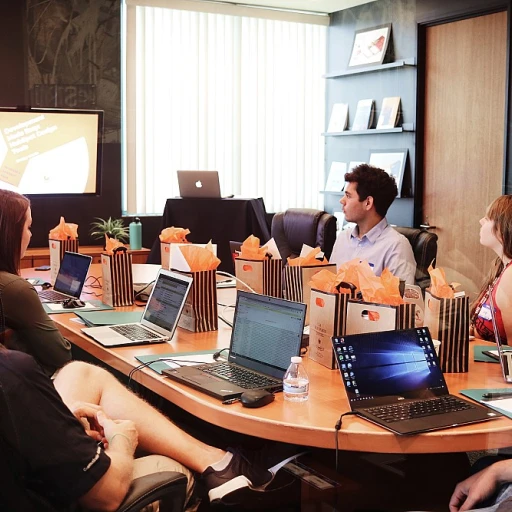
Understanding the Core Principles of Situational Leadership 2
The Foundation of Adaptive Leadership
Understanding the core principles of adaptive leadership is paramount for C-suite executives aiming to steer their organizations successfully through today’s dynamic business landscape. Rooted in situational leadership theories, this approach emphasizes the necessity for leaders to adapt their leadership style to the specific challenges and readiness levels of their teams. At its core, adaptive leadership is about recognizing that there is no one-size-fits-all solution when it comes to managing people. This perspective was significantly influenced by leadership studies focused on how leaders can effectively modify their behavior to match the task at hand and the developmental readiness of their team members. Implementing the situational leadership model involves a keen understanding of both task behavior and relational dynamics. Leaders must accurately assess their team's competence and commitment, adjusting their management style to support the task requirements best. This is where the teachings of seminal works, such as those from Ken Blanchard, become instrumental. Leaders should also consider the development level of each team member, facilitating leadership development programs and leadership training tailored to enhance performance readiness. By prioritizing the individual needs of their team, leaders foster an environment conducive to high task performance and sustained organizational success, helping bridge the gap between leadership theory and real-world application. For C-suite leaders, mastering this adaptive approach equips them to navigate the complexities of executive challenges effectively. It involves learning and refining their capabilities to assess situation-specific demands and responding with the appropriate leadership behavior. To deepen your understanding of navigating these executive complexities, see how partnering with expert recruiters can be a strategic asset in reinforcing your leadership approach.Adapting Leadership Styles to Meet Organizational Needs
Adapting Leadership Styles for Optimal Organizational Impact
Understanding how to adapt leadership styles to meet the evolving needs of an organization is a vital component in implementing situational leadership effectively. At its core, this adaptable approach is well encapsulated in the SLII model, which emphasizes the role of the leader in adjusting their style based on the task at hand and the readiness level of their team members.- Assessing Organizational Needs: Before adapting leadership styles, it's crucial to evaluate what the organization specifically requires. This involves considering the current challenges and goals, as well as the collective capability of your team. By fostering a culture of continuous learning and performance improvement, leaders can better align their style with organizational imperatives.
- Variety of Styles: Different situations demand different leadership styles, ranging from directive to supportive. The situational leadership model underscores this adaptability. High task behavior may be necessary in situations where tasks need clear guidance. Conversely, team members with higher competence commitment may benefit more from supportive behaviors, which promote development.
- Integration of Leadership Theory: Incorporating the insights of leadership studies can further refine your approach. Combining theories with practical applications ensures leaders can effectively navigate any situation, reinforcing their role as facilitators of collective success. This blending of theory and practice can improve management practices across the board.
- Team Development and Readiness: Leaders must also focus on the development level of their teams. Encouraging growth through leadership training and consistent feedback helps increase a team member's readiness level, allowing them to take on more responsibility. As readiness increases, leaders might shift from more directive styles to ones that empower employees, fostering innovation and engagement.
Implementing Situational Leadership in Strategic Decision-Making
Applying Adaptive Leadership for Strategic Impact
Implementing situational leadership in strategic decision-making is not a one-size-fits-all endeavor. Driven by the core tenets of flexibility and responsiveness, today's leaders must adeptly assess varying degrees of task complexity and team member readiness. This approach aligns with the renowned SLII model, offering a structured yet adaptable framework that CEOs and other c-suite leaders can leverage. At the heart of situational leadership lies the recognition that different situations necessitate distinct leadership styles. Leaders must vary their style to suit the task's requirements and the team's development level. This method, advocated by leadership studies, emphasizes the dynamic relationship between a leader's behavior and the attendee's competence and commitment. To successfully implement situational leadership in strategic contexts, consider the following:- Assessment of Readiness: Evaluate the competence and commitment of your team members. Understanding where they fall on the readiness level spectrum—ranging from low to high—is crucial. This assessment should inform the degree of directive or supportive behavior required, ensuring that leadership is tailored to enhance performance readiness.
- Task Complexity: Acknowledge the complexity of each task at hand. Leaders should adjust their task behavior, oscillating between directive and supportive approaches to navigate multifaceted challenges. This adaptability is essential in environments where high-performance outcomes are critical.
- Leadership Style Match: Once task and readiness assessments are in place, the next step involves matching the appropriate leadership style, as advocated by Ken Blanchard's situational model. This congruence amplifies the effectiveness of strategic decision-making processes.
Balancing Flexibility and Consistency in Leadership
Finding the Sweet Spot Between Flexibility and Consistency
In the ever-evolving landscape of corporate leadership, striking the right balance between flexibility and consistency is crucial. Leaders often face the challenge of adapting their leadership style to meet the diverse needs of their team members while maintaining a steady course towards organizational goals. This balancing act is a hallmark of effective situational leadership.
Situational leadership, as conceptualized by Ken Blanchard and Paul Hersey, emphasizes the importance of adjusting leadership styles based on the readiness level of team members. This approach requires leaders to be both flexible and consistent, adapting their behavior to the task at hand while ensuring that their core values and organizational objectives remain unchanged.
Consistency: The Anchor in Leadership
Consistency in leadership provides a stable foundation upon which team members can rely. It fosters trust and sets clear expectations, which are essential for high performance. Leaders who maintain a consistent approach in their communication and decision-making processes create an environment where team members feel secure and understood.
However, consistency should not be mistaken for rigidity. While it's important to have a clear vision and set of values, leaders must remain open to change and innovation. This is where flexibility comes into play.
Flexibility: Adapting to the Needs of the Team
Flexibility in leadership allows for adaptation to the varying needs of team members and the demands of different situations. A leader who can adjust their style—whether it be more directive or supportive—based on the competence and commitment of their team members, is more likely to achieve desired outcomes.
This adaptability is particularly important in today's fast-paced business environment, where change is constant and unpredictable. By being flexible, leaders can respond effectively to new challenges and opportunities, ensuring that their teams remain agile and resilient.
Integrating Flexibility and Consistency
The key to mastering situational leadership lies in integrating flexibility with consistency. Leaders should aim to be consistent in their core values and strategic objectives while remaining flexible in their approach to managing tasks and relationships. This integration not only enhances team development but also drives better performance outcomes.
Leadership training programs, such as those based on the Situational Leadership II (SLII) model, can be instrumental in helping leaders develop the skills needed to balance these two critical aspects. By understanding the nuances of task behavior and relationship behavior, leaders can tailor their approach to suit the development level of each team member, ultimately leading to improved team dynamics and business success.
Leveraging Situational Leadership for Team Development
Propelling Teams Towards Excellence with Situational Leadership
In the dynamic realm of leadership, harnessing the potential of situational leadership can be a game-changer for team development. This leadership model, which emphasizes adapting one's approach based on the needs of the team members, fosters both personal and professional growth within the organization.
As leaders, understanding the varying leadership styles within this model allows you to meet the unique demands of each team member. High-performing teams thrive when leaders identify the competence commitment and readiness level of each individual, tailoring their leadership style to fit. This enhances the ability to guide team members from their current development level to a higher state of performance readiness.
The celebrated model, pioneered by leadership experts in the 1960s, has shown that effectively blending task behavior with relationship behavior encourages engagement and productivity. When teams are presented with challenges, employing a well-suited leadership approach that aligns with their current training and learning stages can be transformative.
At the heart of situational leadership is the necessity for leaders to remain flexible and adaptive, yet consistent in their strategic vision. By doing so, they bolster team performance and nurture an environment of continuous improvement. This not only sharpens individual skills but also empowers teams as a whole to achieve high levels of success.
Measuring the Impact of Adaptive Leadership on Business Outcomes
Evaluating the Effectiveness of Adaptive Leadership Practices
In the ever-evolving landscape of today's business world, the primary measure of effective leadership is its tangible impact on performance and growth. Integrating elements of situational leadership provides a valuable lens for examining these effects. Utilizing this leadership model, C-suite leaders embrace flexibility and adjust their leadership style to accommodate varying readiness levels within their teams. Leaders well-acquainted with the situational leadership approach—originally devised by notable leadership studies—can adeptly manage various team dynamics and organizational changes. To accurately assess the impact of adaptive leadership, consider the following areas:- Performance Metrics: Analyze the improvements in key performance indicators that reflect both team and organizational achievements. An increase in overall productivity, enhanced competence commitment, and successful task completion rates often signal effective situational leadership.
- Development Progression: Observe advancements in team member skills and competencies. Repeated performance readiness assessments help gauge the impact of leadership strategies on individual growth.
- Behavioral Changes: Track any positive transformations in behavior management and relationship behavior within teams. A perceptible shift toward collaboration, coupled with increased autonomy, often indicates that leaders are effectively leveraging the situational leadership model.
- Employee Engagement: Measure levels of engagement and motivation among team members. Adaptive leadership tends to increase commitment and satisfaction, as leaders can tailor their approach to meet specific team needs and developmental levels.














